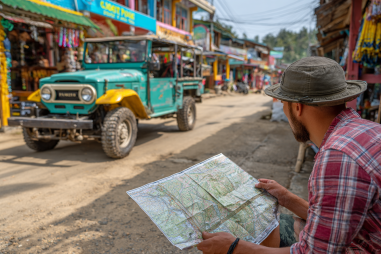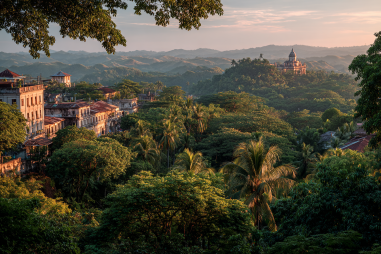Planning a trip to Banaue for the first time is an exciting adventure. Nestled in the mountains of the Philippines, Banaue is famous for its breathtaking rice terraces that have been carved into the landscape for over 2,000 years. This travel guide will help you navigate your way to Banaue, find the perfect places to stay, explore top attractions, understand local culture, and plan your itinerary for an unforgettable visit.
Overview of Banaue
Banaue is a small town in the northern part of the Philippines, in the province of Ifugao. It is best known for the Banaue Rice Terraces, often called the “Eighth Wonder of the World.” These terraces were built by the Ifugao tribe centuries ago and remain a symbol of the Philippines’ rich cultural heritage. Surrounded by lush mountains and dense forests, Banaue offers visitors an opportunity to experience traditional village life, engage with indigenous culture, and enjoy stunning natural landscapes.
How to Reach Banaue by Land and Air
Getting to Banaue can be an adventure itself, and there are a few different ways depending on your starting point. The most common approach is via land travel from Manila or other cities in Luzon.
By Land
The trip from Manila to Banaue takes around 9 to 10 hours by bus or van. Several bus companies operate routes to Banaue, departing from Cubao or Sampaloc terminals in Manila. The route takes you through scenic mountain roads and small towns. If you prefer a more flexible option, private vans or car rentals are available for a more comfortable and quicker journey. Be prepared for winding roads and mountain conditions, so it’s best to travel during the day.
By Air
While Banaue itself does not have an airport, the nearest airport is Loakan Airport in Baguio City, approximately 5 to 6 hours away by land. Another option is to fly into Cauayan Airport in Isabela Province, then continue via land transport to Banaue. From these airports, you can hire a private vehicle or take local buses heading towards Banaue. Though it requires multiple transfers, flying can shorten the overall travel time if you prefer to avoid a long land journey entirely.
Accommodation Options
Banaue offers a variety of accommodation choices to suit different budgets and preferences, ranging from basic inns to eco-friendly lodges with spectacular views of the rice terraces.
- Budget Hostels and Guesthouses: These provide simple rooms with essential amenities, perfect for backpackers or travelers on a budget. Most are located near the town center for easy access to markets and restaurants.
- Mid-range Hotels: Offering more comfort and services such as private bathrooms, WiFi, and sometimes guided tours, these hotels provide a balance between affordability and convenience.
- Eco-Lodges and Resorts: For travelers seeking a more immersive experience, several eco-lodges are situated within or near the rice terraces. These accommodations often offer stunning sunrise views and the opportunity to connect more closely with nature.
It is advisable to book your accommodation well in advance, especially during peak seasons, as rooms can fill up quickly.
Top Attractions and Activities
Banaue is a treasure trove of natural beauty and cultural experiences. Here are some must-see attractions and activities.
- Banaue Rice Terraces: The iconic terraces themselves are the main draw, ideal for hikes, photography, and soaking in breathtaking vistas.
- Viewpoints: Visiting viewpoints such as the Banaue Viewpoint and Kiltepan Viewpoint offers panoramic views of the terraces, particularly stunning at sunrise or sunset.
- Hiking Trails: Several trails lead to nearby villages like Batad and Bangaan, featuring impressive amphitheater-style terraces and waterfalls.
- Local Museums and Cultural Centers: Learn about Ifugao history, crafts, and traditions by visiting local museums or cultural exhibits.
- Visit Indigenous Villages: Experience Ifugao culture firsthand by visiting traditional villages where you can meet locals and see ancient rice farming techniques.
- Waterfalls: Hidden waterfalls such as Tappiyah Falls near Batad offer refreshing stops during hikes.
Best Seasons to Visit
The most favorable time to visit Banaue is during the dry season, which generally runs from November to May. The weather is more pleasant with less rain, making hiking and outdoor activities more enjoyable. The rice terraces are especially beautiful after the planting season (around May), when the fields are lush and green. Avoid the rainy months (June to October) as trails can become slippery and dangerous, and landslides may occur on mountain roads.
Food and Dining Highlights
When in Banaue, don’t miss out on trying traditional Ifugao dishes and local Filipino cuisine.
- Pinikpikan: A traditional Ifugao chicken dish prepared with a unique cooking method that involves lightly beating the chicken before cooking, resulting in distinct flavor and texture.
- Tapuy Rice Wine: A locally brewed rice wine made from glutinous rice, often enjoyed during celebrations.
- Inihaw (Grilled Meats): Simple but delicious grilled pork or chicken are common in eateries around town.
- Fresh vegetables and mountain herbs: The highland terrain means fresh and organic produce is common, so look out for vegetable dishes cooked in traditional ways.
There are several restaurants and cafes in Banaue catering to tourists, but locals’ eateries offer the most authentic dining experiences.
Cultural Etiquette and Safety Tips
Respecting local customs and staying safe makes your travel experience much more enjoyable in Banaue.
- Respect Indigenous Traditions: Always ask before taking photos of people or their property. Be mindful of local rituals and festivals.
- Dress Appropriately: Modest clothing is appreciated, especially when visiting villages or places of cultural significance.
- Environmentally Responsible: Preserve nature by not littering and being cautious when hiking to protect the fragile environment.
- Health and Safety: Bring insect repellent and suitable hiking shoes. Drink bottled water and avoid street food that may not meet hygiene standards.
Additionally, road conditions can be tricky, so engage experienced drivers if you are using private transport and always keep an eye on weather reports during the rainy season.
Suggested Itineraries for Varying Trip Lengths
Planning your days carefully can help you make the most of Banaue whether you have just a short visit or a longer stay.
2-Day Itinerary
- Day 1: Arrive in Banaue, check into your accommodation, visit the Banaue Rice Terraces viewpoint, and explore the town center.
- Day 2: Take a day hike to Batad Rice Terraces and Tappiyah Falls, returning in the afternoon for a relaxing evening.
4-Day Itinerary
- Day 1: Travel to Banaue and settle in.
- Day 2: Explore the Banaue Rice Terraces and local museums.
- Day 3: Full day hike to Batad and surrounding villages.
- Day 4: Visit Bangaan Village and nearby cultural sites before departure.
1-Week Itinerary
- Days 1-2: Arrival and Banaue town exploration.
- Days 3-4: Extended hikes to Batad and other terraces.
- Day 5: Participate in local workshops or cultural tours.
- Days 6-7: Relax and discover nearby attractions like Hapao Rice Terraces or Bontoc, then prepare for departure.
Adjust the itinerary based on your interests, fitness level, and how much time you want to dedicate to hiking or cultural immersion.
Making the Most of Your Banaue Trip
Banaue is a destination that rewards visitors with its majestic landscapes and rich cultural experiences. By planning ahead, respecting local customs, and choosing the right time to visit, you’ll be able to enjoy a smooth and memorable journey. Whether you’re marveling at the rice terraces, hiking to pristine villages, or tasting local delicacies, every moment in Banaue offers a glimpse into an extraordinary world shaped by centuries of tradition and natural beauty. Pack your bags, bring an open heart, and get ready to discover the enchanting mountains of Banaue.







